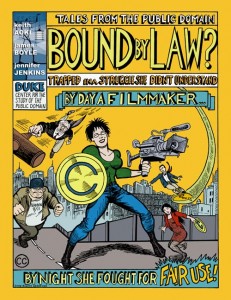by Alice Whiteside, information literacy librarian with the Penn State University Libraries
Are you working on a multimedia project for a class this semester or putting together something spectacular for the Sustainable State Video Contest? Many of you probably know that you can get articles (from scholarly journals, newspapers, and magazines) through our library databases, but you might not know that our library databases also give you access to thousands of amazing photographs, art images, and even video clips of historical television.

As you use these in your own projects, it’s important that you proceed with a rudimentary understanding of U.S. copyright law. Know the rules and also your rights!
You Usually Need Permission to Reuse Copyrighted Media
Creative works are the intellectual property of the people who made them, and using them without permission is stealing—it’s unethical and illegal. Under U.S. copyright law, you have to get permission from the author or creator (or the copyright holder, who may, for instance, be a descendant of the author) of any creative work before you can copy it or sample from it. Copyright protection is automatic (an author must opt out rather than opt in) and extends for 70 years after an author’s death.
But Not If It’s Fair Use!

Certain uses of copyrighted material are allowed, both ethically and legally, under an exception called “fair use.” Fair use can include reproducing a work or a part of a work within the context of criticism, parody, news reporting, teaching, or scholarship. Educational uses (like a class project) are usually covered by fair use, but if your class project is posted on the open web, this gets much more complicated. To learn more about fair use, check out this comic book from Duke University’s Center for the Study of the Public Domain.
If you’re ever unsure if a particular use of an image is okay, feel free to ask a librarian!
Creative Commons Licenses
In the resources I list below, the term Creative Commons comes up frequently. Creative Commons is an alternative license that authors and artists can choose to apply to their work, allowing greater flexibility for how others redistribute and reuse the work and still protecting their intellectual property rights.
For you, it means that you can legally reuse and remix these materials in your own projects, as long as you give proper credit and respect any other limitations chosen by the creator of the work you are using.
Free Media Library—Music, Images, and Video
The wonderful folks in the Penn State Media Commons have compiled a list of multimedia resources in the Free Media Library.
Some of these are Creative Commons licensed and freely available; some are free to you as Penn State students because the University has purchased a subscription to these databases. Pay attention to the licensing information they have listed, and also have a look at their links about fair use.

- Background music—If you’re making a video or podcast and want to add a bit of background music (but aren’t a musician yourself), the audio sources listed in the Free Media Library are just what you need. There are a number of sites with Creative Commons licensed music that you can download for free and use in your project.
- Photographs of people or places—If you are looking for photographs of people or places (or sunsets, construction cranes, giraffes, broccoli, etc., etc.) Flickr’s Creative Commons search is one of the best places to go. It’s usually a better bet than Google Images for a number reasons which are nicely articulated in A Complete Guide to Finding and Using Incredible Flickr Images (this post is a few years old but still quite relevant, and it includes a great summary of the different Creative Commons licenses too).
Free Media Courtesy of Your (Future) Alma Mater—Images, Videos, and More
The Penn State Libraries have a ton of image resources, from art to news to maps to botanical specimens. This guide gives an overview of where to look for what. Many of these are licensed databases with specific rules about appropriate uses. Here are a few examples:
- Guide to news photographs databases—If you are interested in looking back in time, we have a vast array of historical news photographs in our collections, available online right here at your fingertips.
- Vanderbilt Television News Archive—You can stream historical television news from CNN and NBC.
- ARTStor—This has amazing, high-quality images (that are really fun to browse, especially if you have any interest in art), but these are licensed only for educational use and shouldn’t be posted on the open web.
Last but not least, check out our Digitized Collections, which include photographs, scanned manuscripts, maps, streaming video, books, journals, and more. We are creating new collections every year, so keep an eye out for new additions!
This post was written by Alice Whiteside, information literacy librarian with the Penn State University Libraries.



